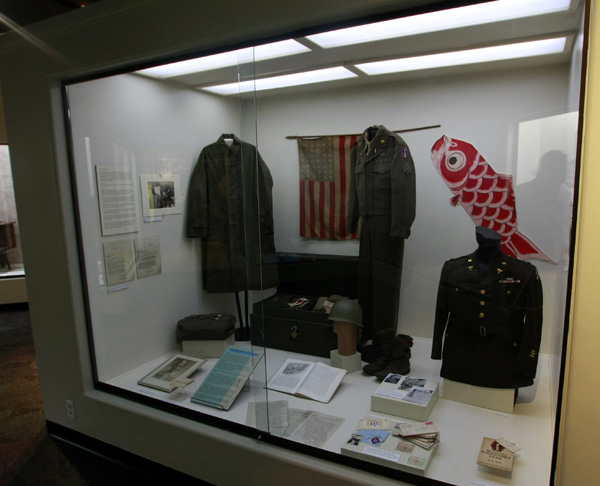Museum of Riverside

Reading the Walls Online Exhibit - Room #2 : Case 8
A Question of Loyalty and the 442nd Regimental Combat Team

President Roosevelt announced, "No loyal citizen of the United States should be denied the democratic right
to exercise the responsibilities of his citizenship, regardless of race or
ancestry . . . Americanism is not, and never was, a matter of race or ancestry.
Every loyal American citizen should be given the opportunity to serve this
country . . . in the ranks of our armed forces . . ." Franklin D. Roosevelt,
February 1, 1943 upon activating the 442nd Regimental Combat Team. February 1, 1943 that
loyal Nisei men could enlist in the armed services. In order to determine
loyalty, the government designed the "Application for Leave Clearance"
questionnaire, aka the "loyalty questionnaire." Different versions of this
questionnaire were given to all male and female evacuees. In particular,
Questions 27 and 28 became the defining questions for this loyalty test:
Question 27: Are you willing to serve in the armed forces of the United States on combat duty, wherever ordered?
Question 28: Will you swear unqualified allegiance to the United States of America and faithfully defend the United States from any or all attack by foreign or domestic forces, and forswear any form of allegiance or obedience to the Japanese emperor, or any other foreign government, power or organization?
Internees were concerned that based upon their answers, they could be subjected to further persecution and separated from their families. In fact, those who were designated as disloyal were relocated to the Tule Lake Internment Camp, a ‘segregation camp’ for dissidents, criminals, and those wishing to return to Japan.
For the Issei (immigrants born in Japan), if they answered "Yes" to questions 27 and 28, they were persons without a country because they could not become United States citizens and they were renouncing their Japanese citizenship.
The native-born Nisei found it difficult to pledge to defend the country that had deprived them of their constitutional rights, while being forced to admit a presumed allegiance to Japan.
The questionnaire frequently divided family members, including the Haradas. Clark Harada voiced his reservations about defending a country which incarcerated its citizens, while Harold and Yoshizo Harada embraced the opportunity to demonstrate their patriotism for their country.


